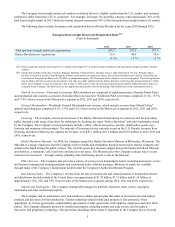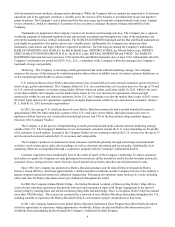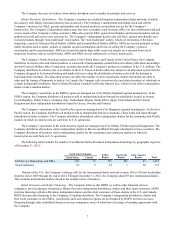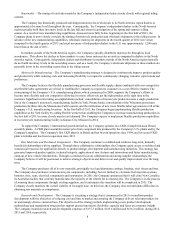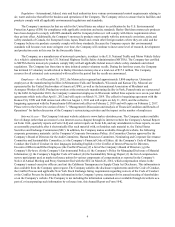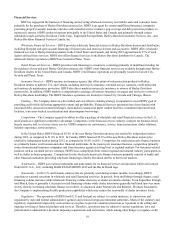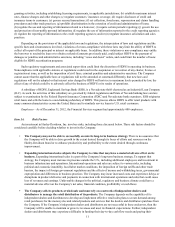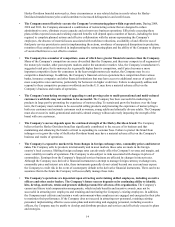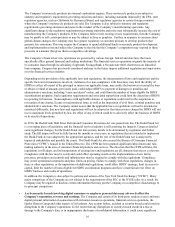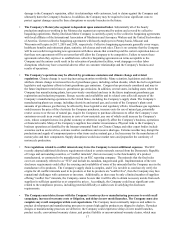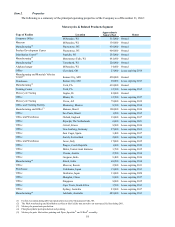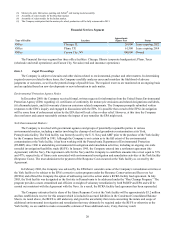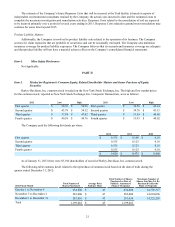Harley Davidson 2012 Annual Report Download - page 15
Download and view the complete annual report
Please find page 15 of the 2012 Harley Davidson annual report below. You can navigate through the pages in the report by either clicking on the pages listed below, or by using the keyword search tool below to find specific information within the annual report.15
• The Company incurs substantial costs with respect to employee pension and healthcare benefits. The Company’s
cash funding requirements and its estimates of liabilities and expenses for pensions and healthcare benefits for both
active and retired employees are based on several factors that are outside the Company’s control. These factors include
funding requirements of the Pension Protection Act of 2006, the rate used to discount the future estimated liability, the
rate of return on plan assets, current and projected healthcare costs, healthcare reform or legislation, retirement age
and mortality. Changes in these factors can impact the expense, liabilities and cash requirements associated with these
benefits which could have a material adverse effect on future results of operations, liquidity or shareholders’ equity. In
addition, costs associated with these benefits put the Company under significant cost pressure as compared to its
competitors that may not bear the costs of similar benefit plans. Furthermore, costs associated with complying with
the Patient Protection and Affordable Care Act may produce additional cost pressure on the Company and its health
care plans.
• The Company manufactures products that create exposure to product liability claims and litigation. To the
extent plaintiffs are successful in showing that personal injury or property damage result from defects in the design or
manufacture of the Company’s products, the Company may be subject to claims for damages that are not covered by
insurance. The costs associated with defending product liability claims, including frivolous lawsuits, and payment of
damages could be substantial. The Company’s reputation may also be adversely affected by such claims, whether or
not successful.
• The Company must maintain stakeholder confidence in its operating ethics and corporate governance
practices. The Company believes it has a history of good corporate governance. Prior to the enactment of the
Sarbanes-Oxley Act of 2002, the Company had in place many of the corporate governance procedures and processes
now mandated by the Sarbanes-Oxley Act and related rules and regulations, such as Board Committee Charters and a
Corporate Governance Policy. In 1992, the Company established a Code of Business Conduct that defines how
employees interact with various Company stakeholders and addresses issues such as confidentiality, conflict of interest
and fair dealing. Failure to maintain its reputation for good corporate governance may have a material adverse effect
on the Company’s business and results of operations.
• The Company is and may in the future become subject to legal proceedings and commercial or contractual
disputes. These are typically claims that arise in the normal course of business. The uncertainty associated with
substantial unresolved claims and lawsuits may harm the Company’s business, financial condition, reputation and
brand. The defense of the lawsuits may result in the expenditures of significant financial resources and the diversion of
management’s time and attention away from business operations. In addition, although the Company is unable to
determine the amount, if any, that it may be required to pay in connection with the resolution of the lawsuits by
settlement or otherwise, any such payment may have a material adverse effect on the Company’s business and results
of operations. Refer to the Company’s disclosures concerning legal proceedings in the periodic reports that the
Company files with the Securities and Exchange Commission for additional detail regarding lawsuits and other claims
against the Company.
• The Company must comply with governmental laws and regulations that are subject to change and involve
significant costs. The Company’s sales and operations in areas outside the U.S. may be subject to foreign laws,
regulations and the legal systems of foreign courts or tribunals. These laws and policies governing operations of
foreign-based companies may result in increased costs or restrictions on the ability of the Company to sell its products
in certain countries. The Company’s international sales operations may also be adversely affected by U. S. laws
affecting foreign trade and taxation.
The Company is subject to income and non-income based taxes in the U.S. and in various foreign jurisdictions.
Significant judgment is required in determining the Company's worldwide income tax liabilities and other tax
liabilities. The Company believes that it complies with applicable tax law. If the governing tax authorities have a
different interpretation of the applicable law or if there is a change in tax law, the Company's financial condition and/
or results of operations may be adversely affected.
The Company’s domestic sales and operations are subject to governmental policies and regulatory actions of agencies
of the United States Government, including the Environmental Protection Agency (“EPA”), SEC, National Highway
Traffic Safety Administration, Department of Labor and Federal Trade Commission. In addition, the Company’s sales
and operations are also subject to laws and actions of state legislatures and other local regulators, including dealer
statutes and licensing laws. Changes in regulations or the imposition of additional regulations may have a material
adverse effect on the Company’s business and results of operations.


